Principles of Leadership and Management: Waitrose Case Study Report
VerifiedAdded on 2020/12/09
|15
|4781
|173
Report
AI Summary
This report delves into the core principles of leadership and management, using Waitrose as a case study. It examines the importance of defining objectives, analyzing the impact of decision-making, and obtaining sufficient information for effective choices. The report differentiates between managers and leaders, exploring various leadership styles and their contexts. It analyzes motivation theories, such as Maslow's hierarchy and Herzberg's two-factor theory, and their application in the workplace. The report further explores the responsibilities of managers, their role in achieving organizational objectives, and the application of management theories. It also defines the features of a performance measurement system, the application of tools for monitoring business performance, and the distinction between outcomes and outputs.
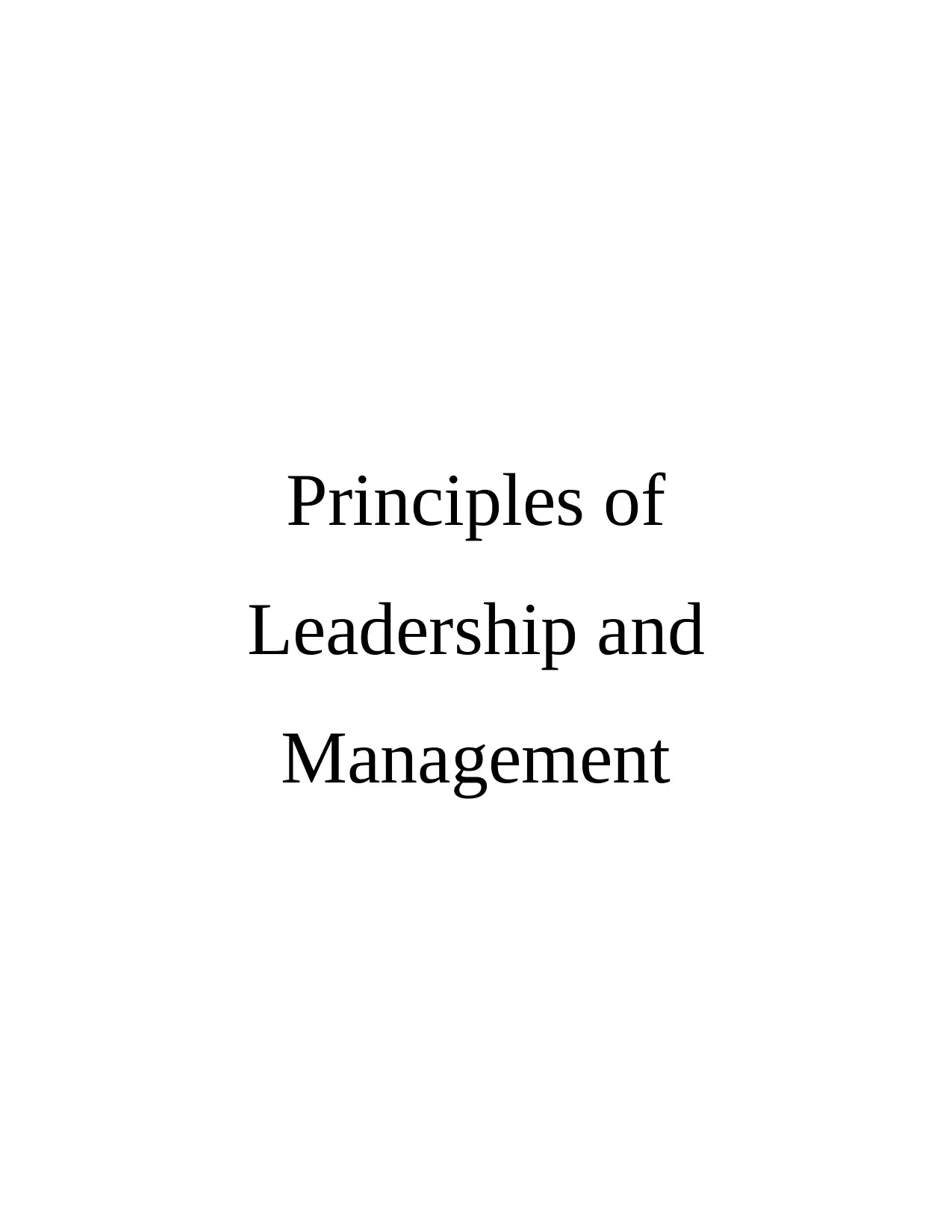
Principles of
Leadership and
Management
Leadership and
Management
Paraphrase This Document
Need a fresh take? Get an instant paraphrase of this document with our AI Paraphraser
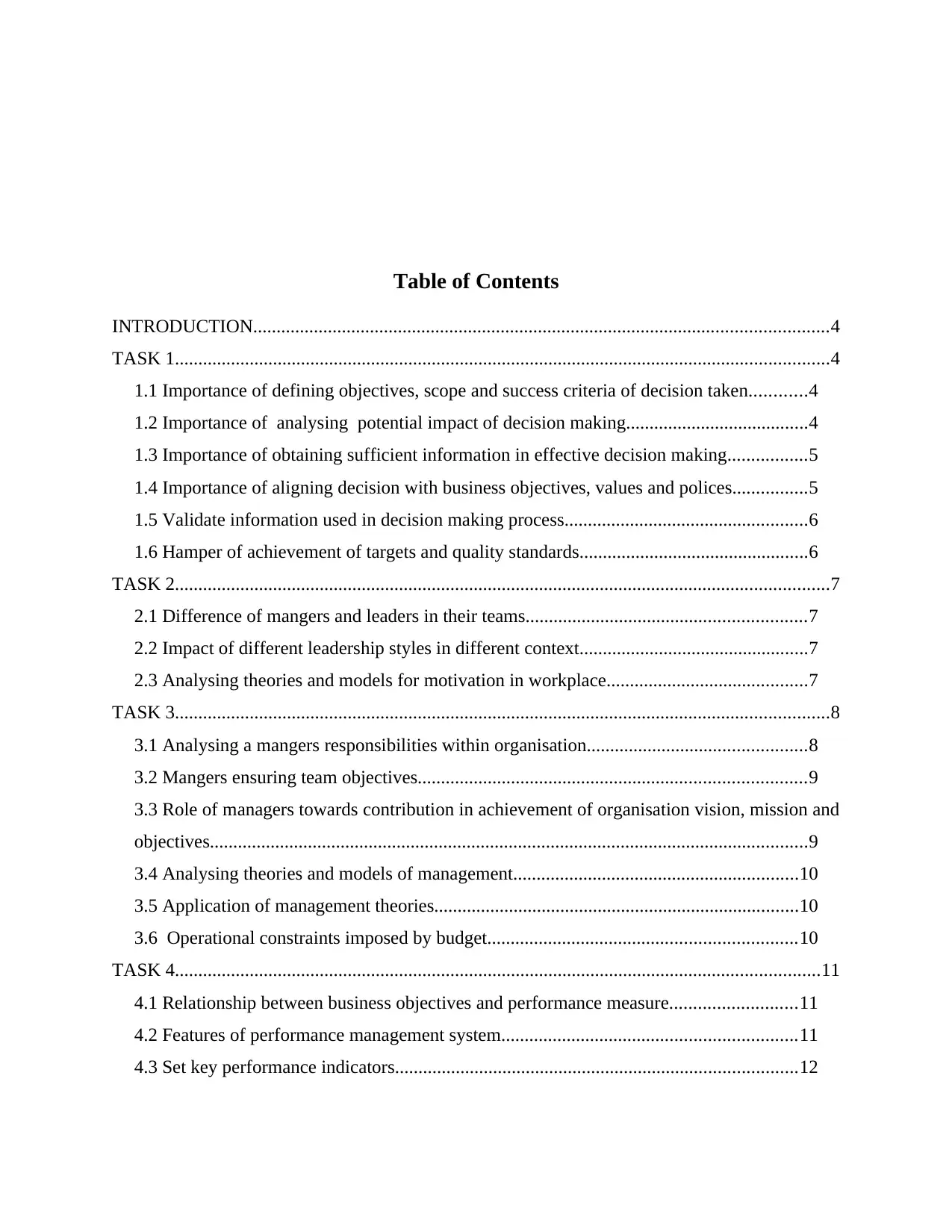
Table of Contents
INTRODUCTION...........................................................................................................................4
TASK 1............................................................................................................................................4
1.1 Importance of defining objectives, scope and success criteria of decision taken............4
1.2 Importance of analysing potential impact of decision making.......................................4
1.3 Importance of obtaining sufficient information in effective decision making.................5
1.4 Importance of aligning decision with business objectives, values and polices................5
1.5 Validate information used in decision making process....................................................6
1.6 Hamper of achievement of targets and quality standards.................................................6
TASK 2............................................................................................................................................7
2.1 Difference of mangers and leaders in their teams............................................................7
2.2 Impact of different leadership styles in different context.................................................7
2.3 Analysing theories and models for motivation in workplace...........................................7
TASK 3............................................................................................................................................8
3.1 Analysing a mangers responsibilities within organisation...............................................8
3.2 Mangers ensuring team objectives...................................................................................9
3.3 Role of managers towards contribution in achievement of organisation vision, mission and
objectives................................................................................................................................9
3.4 Analysing theories and models of management.............................................................10
3.5 Application of management theories..............................................................................10
3.6 Operational constraints imposed by budget..................................................................10
TASK 4..........................................................................................................................................11
4.1 Relationship between business objectives and performance measure...........................11
4.2 Features of performance management system...............................................................11
4.3 Set key performance indicators......................................................................................12
INTRODUCTION...........................................................................................................................4
TASK 1............................................................................................................................................4
1.1 Importance of defining objectives, scope and success criteria of decision taken............4
1.2 Importance of analysing potential impact of decision making.......................................4
1.3 Importance of obtaining sufficient information in effective decision making.................5
1.4 Importance of aligning decision with business objectives, values and polices................5
1.5 Validate information used in decision making process....................................................6
1.6 Hamper of achievement of targets and quality standards.................................................6
TASK 2............................................................................................................................................7
2.1 Difference of mangers and leaders in their teams............................................................7
2.2 Impact of different leadership styles in different context.................................................7
2.3 Analysing theories and models for motivation in workplace...........................................7
TASK 3............................................................................................................................................8
3.1 Analysing a mangers responsibilities within organisation...............................................8
3.2 Mangers ensuring team objectives...................................................................................9
3.3 Role of managers towards contribution in achievement of organisation vision, mission and
objectives................................................................................................................................9
3.4 Analysing theories and models of management.............................................................10
3.5 Application of management theories..............................................................................10
3.6 Operational constraints imposed by budget..................................................................10
TASK 4..........................................................................................................................................11
4.1 Relationship between business objectives and performance measure...........................11
4.2 Features of performance management system...............................................................11
4.3 Set key performance indicators......................................................................................12
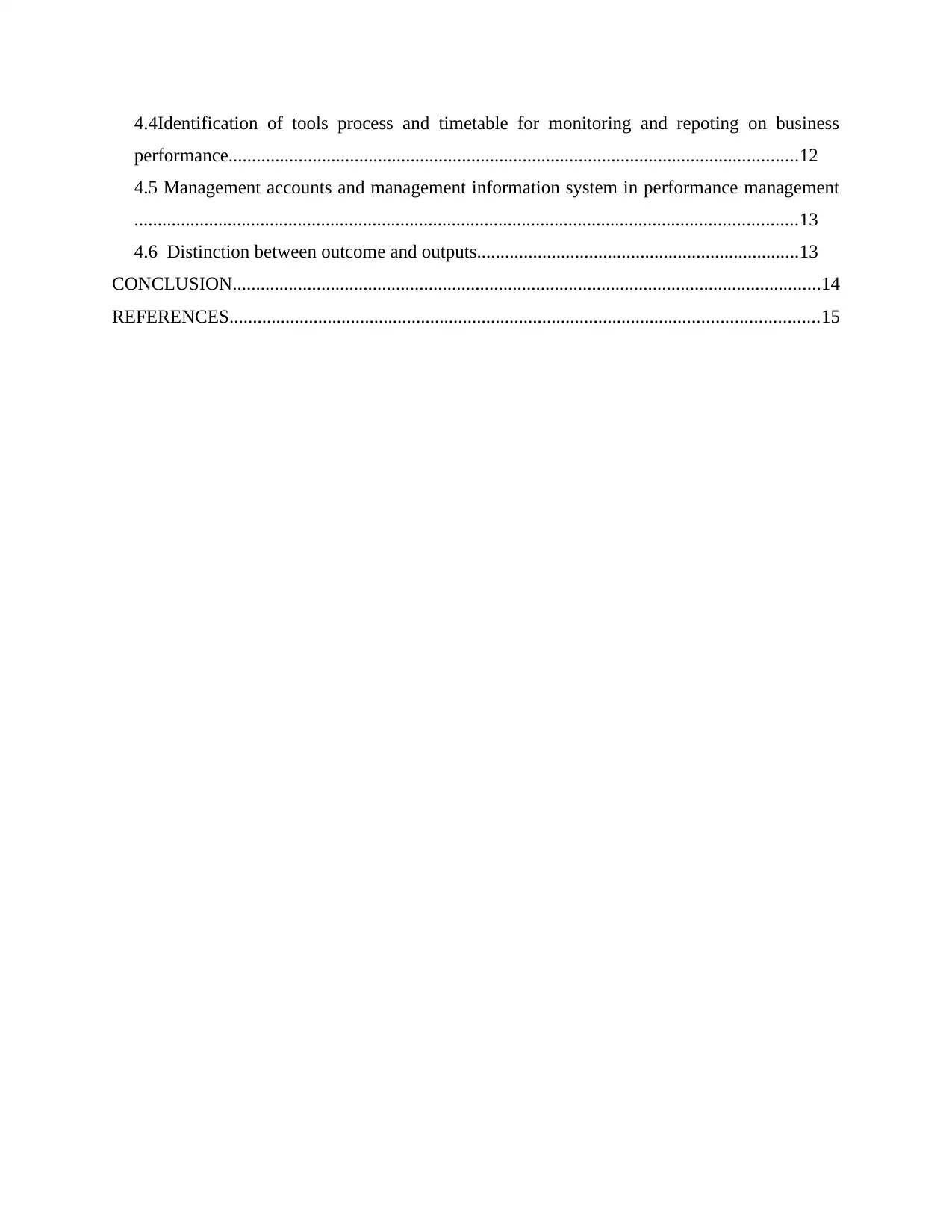
4.4Identification of tools process and timetable for monitoring and repoting on business
performance..........................................................................................................................12
4.5 Management accounts and management information system in performance management
..............................................................................................................................................13
4.6 Distinction between outcome and outputs.....................................................................13
CONCLUSION..............................................................................................................................14
REFERENCES..............................................................................................................................15
performance..........................................................................................................................12
4.5 Management accounts and management information system in performance management
..............................................................................................................................................13
4.6 Distinction between outcome and outputs.....................................................................13
CONCLUSION..............................................................................................................................14
REFERENCES..............................................................................................................................15
⊘ This is a preview!⊘
Do you want full access?
Subscribe today to unlock all pages.

Trusted by 1+ million students worldwide
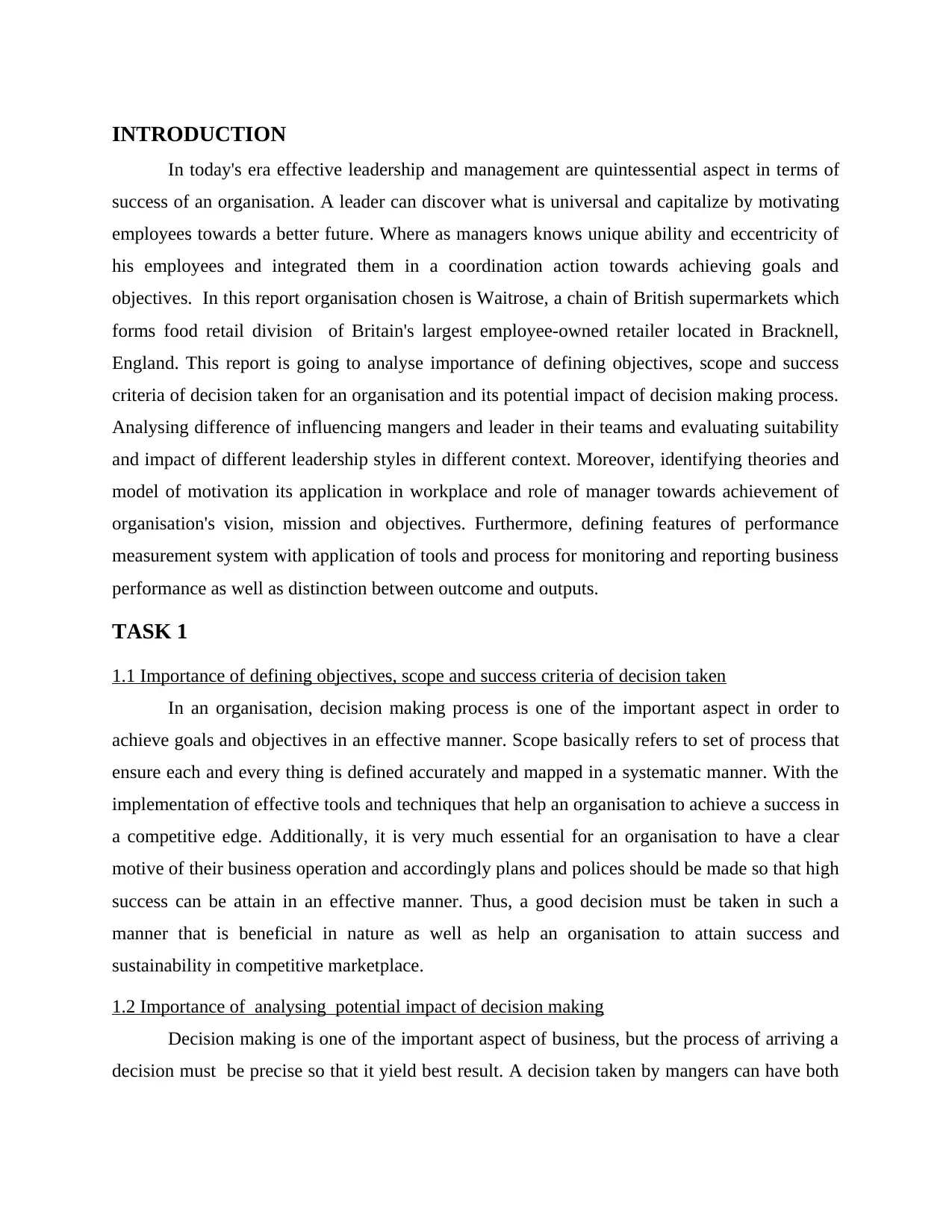
INTRODUCTION
In today's era effective leadership and management are quintessential aspect in terms of
success of an organisation. A leader can discover what is universal and capitalize by motivating
employees towards a better future. Where as managers knows unique ability and eccentricity of
his employees and integrated them in a coordination action towards achieving goals and
objectives. In this report organisation chosen is Waitrose, a chain of British supermarkets which
forms food retail division of Britain's largest employee-owned retailer located in Bracknell,
England. This report is going to analyse importance of defining objectives, scope and success
criteria of decision taken for an organisation and its potential impact of decision making process.
Analysing difference of influencing mangers and leader in their teams and evaluating suitability
and impact of different leadership styles in different context. Moreover, identifying theories and
model of motivation its application in workplace and role of manager towards achievement of
organisation's vision, mission and objectives. Furthermore, defining features of performance
measurement system with application of tools and process for monitoring and reporting business
performance as well as distinction between outcome and outputs.
TASK 1
1.1 Importance of defining objectives, scope and success criteria of decision taken
In an organisation, decision making process is one of the important aspect in order to
achieve goals and objectives in an effective manner. Scope basically refers to set of process that
ensure each and every thing is defined accurately and mapped in a systematic manner. With the
implementation of effective tools and techniques that help an organisation to achieve a success in
a competitive edge. Additionally, it is very much essential for an organisation to have a clear
motive of their business operation and accordingly plans and polices should be made so that high
success can be attain in an effective manner. Thus, a good decision must be taken in such a
manner that is beneficial in nature as well as help an organisation to attain success and
sustainability in competitive marketplace.
1.2 Importance of analysing potential impact of decision making
Decision making is one of the important aspect of business, but the process of arriving a
decision must be precise so that it yield best result. A decision taken by mangers can have both
In today's era effective leadership and management are quintessential aspect in terms of
success of an organisation. A leader can discover what is universal and capitalize by motivating
employees towards a better future. Where as managers knows unique ability and eccentricity of
his employees and integrated them in a coordination action towards achieving goals and
objectives. In this report organisation chosen is Waitrose, a chain of British supermarkets which
forms food retail division of Britain's largest employee-owned retailer located in Bracknell,
England. This report is going to analyse importance of defining objectives, scope and success
criteria of decision taken for an organisation and its potential impact of decision making process.
Analysing difference of influencing mangers and leader in their teams and evaluating suitability
and impact of different leadership styles in different context. Moreover, identifying theories and
model of motivation its application in workplace and role of manager towards achievement of
organisation's vision, mission and objectives. Furthermore, defining features of performance
measurement system with application of tools and process for monitoring and reporting business
performance as well as distinction between outcome and outputs.
TASK 1
1.1 Importance of defining objectives, scope and success criteria of decision taken
In an organisation, decision making process is one of the important aspect in order to
achieve goals and objectives in an effective manner. Scope basically refers to set of process that
ensure each and every thing is defined accurately and mapped in a systematic manner. With the
implementation of effective tools and techniques that help an organisation to achieve a success in
a competitive edge. Additionally, it is very much essential for an organisation to have a clear
motive of their business operation and accordingly plans and polices should be made so that high
success can be attain in an effective manner. Thus, a good decision must be taken in such a
manner that is beneficial in nature as well as help an organisation to attain success and
sustainability in competitive marketplace.
1.2 Importance of analysing potential impact of decision making
Decision making is one of the important aspect of business, but the process of arriving a
decision must be precise so that it yield best result. A decision taken by mangers can have both
Paraphrase This Document
Need a fresh take? Get an instant paraphrase of this document with our AI Paraphraser
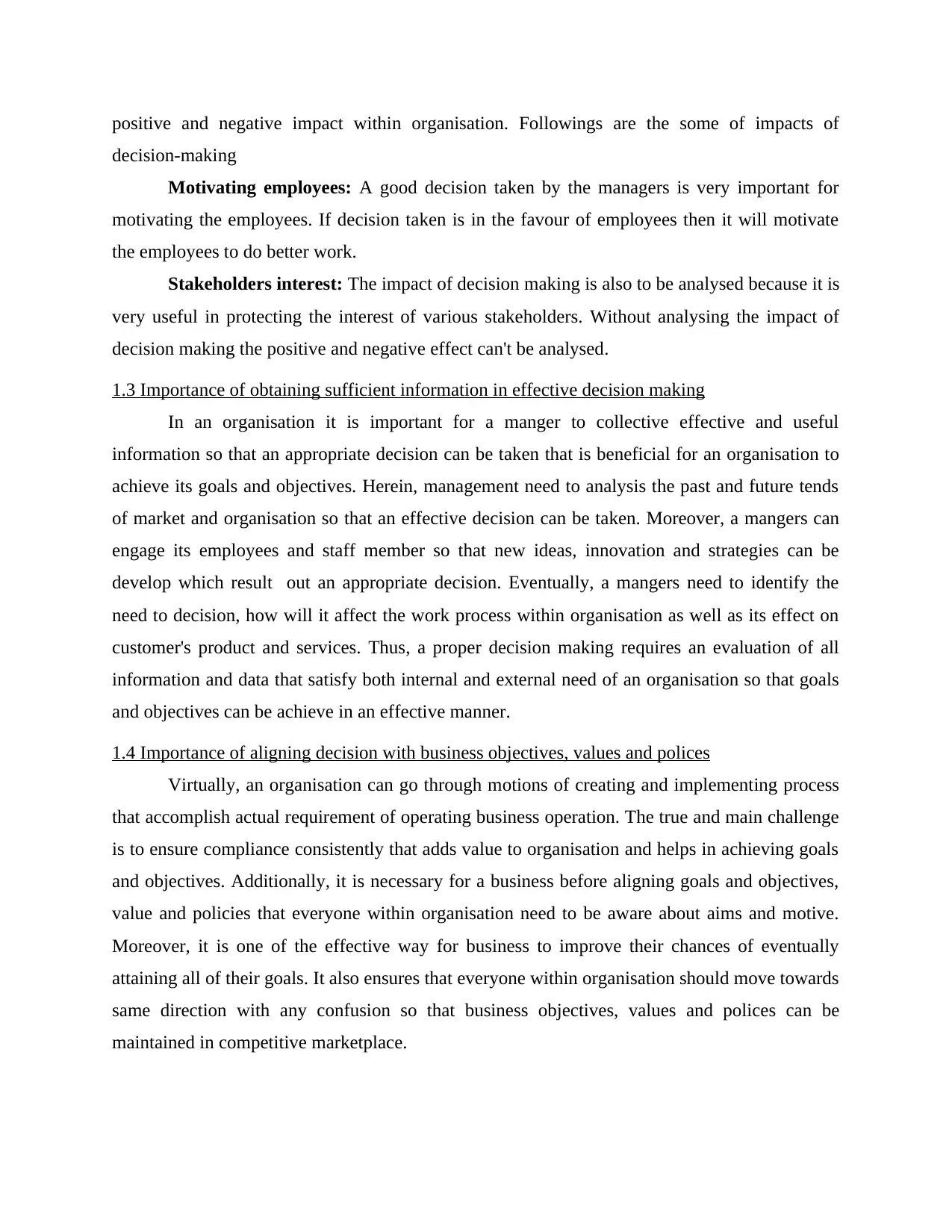
positive and negative impact within organisation. Followings are the some of impacts of
decision-making
Motivating employees: A good decision taken by the managers is very important for
motivating the employees. If decision taken is in the favour of employees then it will motivate
the employees to do better work.
Stakeholders interest: The impact of decision making is also to be analysed because it is
very useful in protecting the interest of various stakeholders. Without analysing the impact of
decision making the positive and negative effect can't be analysed.
1.3 Importance of obtaining sufficient information in effective decision making
In an organisation it is important for a manger to collective effective and useful
information so that an appropriate decision can be taken that is beneficial for an organisation to
achieve its goals and objectives. Herein, management need to analysis the past and future tends
of market and organisation so that an effective decision can be taken. Moreover, a mangers can
engage its employees and staff member so that new ideas, innovation and strategies can be
develop which result out an appropriate decision. Eventually, a mangers need to identify the
need to decision, how will it affect the work process within organisation as well as its effect on
customer's product and services. Thus, a proper decision making requires an evaluation of all
information and data that satisfy both internal and external need of an organisation so that goals
and objectives can be achieve in an effective manner.
1.4 Importance of aligning decision with business objectives, values and polices
Virtually, an organisation can go through motions of creating and implementing process
that accomplish actual requirement of operating business operation. The true and main challenge
is to ensure compliance consistently that adds value to organisation and helps in achieving goals
and objectives. Additionally, it is necessary for a business before aligning goals and objectives,
value and policies that everyone within organisation need to be aware about aims and motive.
Moreover, it is one of the effective way for business to improve their chances of eventually
attaining all of their goals. It also ensures that everyone within organisation should move towards
same direction with any confusion so that business objectives, values and polices can be
maintained in competitive marketplace.
decision-making
Motivating employees: A good decision taken by the managers is very important for
motivating the employees. If decision taken is in the favour of employees then it will motivate
the employees to do better work.
Stakeholders interest: The impact of decision making is also to be analysed because it is
very useful in protecting the interest of various stakeholders. Without analysing the impact of
decision making the positive and negative effect can't be analysed.
1.3 Importance of obtaining sufficient information in effective decision making
In an organisation it is important for a manger to collective effective and useful
information so that an appropriate decision can be taken that is beneficial for an organisation to
achieve its goals and objectives. Herein, management need to analysis the past and future tends
of market and organisation so that an effective decision can be taken. Moreover, a mangers can
engage its employees and staff member so that new ideas, innovation and strategies can be
develop which result out an appropriate decision. Eventually, a mangers need to identify the
need to decision, how will it affect the work process within organisation as well as its effect on
customer's product and services. Thus, a proper decision making requires an evaluation of all
information and data that satisfy both internal and external need of an organisation so that goals
and objectives can be achieve in an effective manner.
1.4 Importance of aligning decision with business objectives, values and polices
Virtually, an organisation can go through motions of creating and implementing process
that accomplish actual requirement of operating business operation. The true and main challenge
is to ensure compliance consistently that adds value to organisation and helps in achieving goals
and objectives. Additionally, it is necessary for a business before aligning goals and objectives,
value and policies that everyone within organisation need to be aware about aims and motive.
Moreover, it is one of the effective way for business to improve their chances of eventually
attaining all of their goals. It also ensures that everyone within organisation should move towards
same direction with any confusion so that business objectives, values and polices can be
maintained in competitive marketplace.
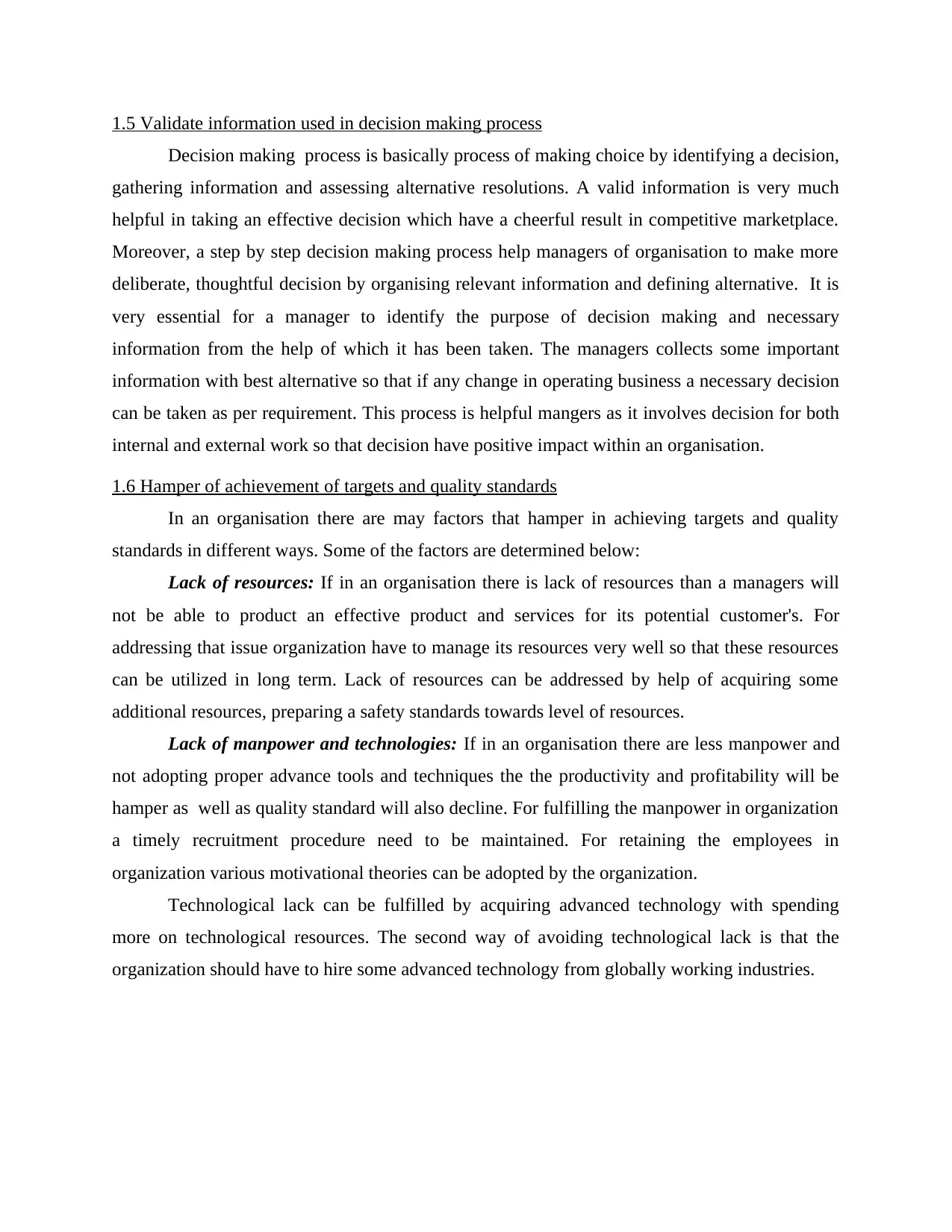
1.5 Validate information used in decision making process
Decision making process is basically process of making choice by identifying a decision,
gathering information and assessing alternative resolutions. A valid information is very much
helpful in taking an effective decision which have a cheerful result in competitive marketplace.
Moreover, a step by step decision making process help managers of organisation to make more
deliberate, thoughtful decision by organising relevant information and defining alternative. It is
very essential for a manager to identify the purpose of decision making and necessary
information from the help of which it has been taken. The managers collects some important
information with best alternative so that if any change in operating business a necessary decision
can be taken as per requirement. This process is helpful mangers as it involves decision for both
internal and external work so that decision have positive impact within an organisation.
1.6 Hamper of achievement of targets and quality standards
In an organisation there are may factors that hamper in achieving targets and quality
standards in different ways. Some of the factors are determined below:
Lack of resources: If in an organisation there is lack of resources than a managers will
not be able to product an effective product and services for its potential customer's. For
addressing that issue organization have to manage its resources very well so that these resources
can be utilized in long term. Lack of resources can be addressed by help of acquiring some
additional resources, preparing a safety standards towards level of resources.
Lack of manpower and technologies: If in an organisation there are less manpower and
not adopting proper advance tools and techniques the the productivity and profitability will be
hamper as well as quality standard will also decline. For fulfilling the manpower in organization
a timely recruitment procedure need to be maintained. For retaining the employees in
organization various motivational theories can be adopted by the organization.
Technological lack can be fulfilled by acquiring advanced technology with spending
more on technological resources. The second way of avoiding technological lack is that the
organization should have to hire some advanced technology from globally working industries.
Decision making process is basically process of making choice by identifying a decision,
gathering information and assessing alternative resolutions. A valid information is very much
helpful in taking an effective decision which have a cheerful result in competitive marketplace.
Moreover, a step by step decision making process help managers of organisation to make more
deliberate, thoughtful decision by organising relevant information and defining alternative. It is
very essential for a manager to identify the purpose of decision making and necessary
information from the help of which it has been taken. The managers collects some important
information with best alternative so that if any change in operating business a necessary decision
can be taken as per requirement. This process is helpful mangers as it involves decision for both
internal and external work so that decision have positive impact within an organisation.
1.6 Hamper of achievement of targets and quality standards
In an organisation there are may factors that hamper in achieving targets and quality
standards in different ways. Some of the factors are determined below:
Lack of resources: If in an organisation there is lack of resources than a managers will
not be able to product an effective product and services for its potential customer's. For
addressing that issue organization have to manage its resources very well so that these resources
can be utilized in long term. Lack of resources can be addressed by help of acquiring some
additional resources, preparing a safety standards towards level of resources.
Lack of manpower and technologies: If in an organisation there are less manpower and
not adopting proper advance tools and techniques the the productivity and profitability will be
hamper as well as quality standard will also decline. For fulfilling the manpower in organization
a timely recruitment procedure need to be maintained. For retaining the employees in
organization various motivational theories can be adopted by the organization.
Technological lack can be fulfilled by acquiring advanced technology with spending
more on technological resources. The second way of avoiding technological lack is that the
organization should have to hire some advanced technology from globally working industries.
⊘ This is a preview!⊘
Do you want full access?
Subscribe today to unlock all pages.

Trusted by 1+ million students worldwide
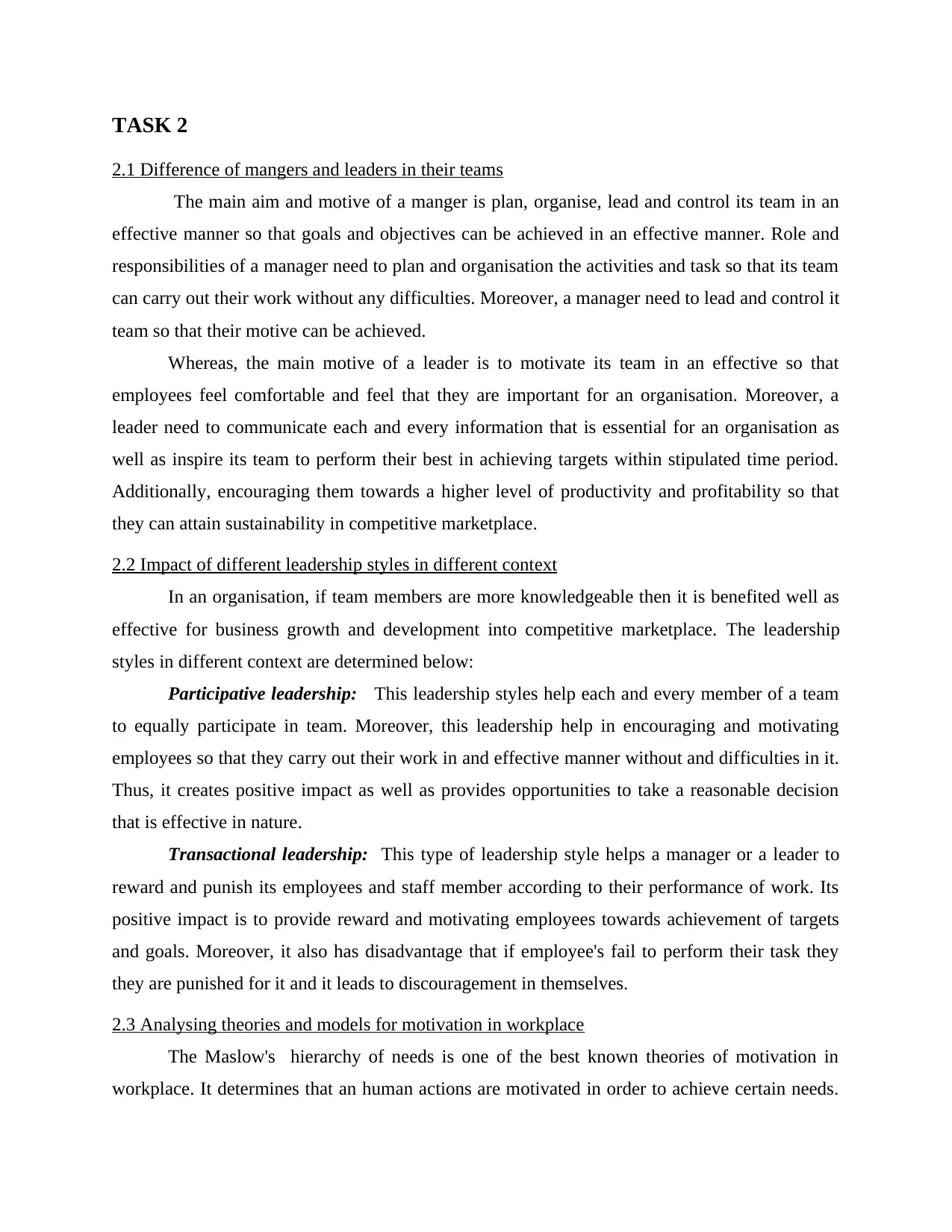
TASK 2
2.1 Difference of mangers and leaders in their teams
The main aim and motive of a manger is plan, organise, lead and control its team in an
effective manner so that goals and objectives can be achieved in an effective manner. Role and
responsibilities of a manager need to plan and organisation the activities and task so that its team
can carry out their work without any difficulties. Moreover, a manager need to lead and control it
team so that their motive can be achieved.
Whereas, the main motive of a leader is to motivate its team in an effective so that
employees feel comfortable and feel that they are important for an organisation. Moreover, a
leader need to communicate each and every information that is essential for an organisation as
well as inspire its team to perform their best in achieving targets within stipulated time period.
Additionally, encouraging them towards a higher level of productivity and profitability so that
they can attain sustainability in competitive marketplace.
2.2 Impact of different leadership styles in different context
In an organisation, if team members are more knowledgeable then it is benefited well as
effective for business growth and development into competitive marketplace. The leadership
styles in different context are determined below:
Participative leadership: This leadership styles help each and every member of a team
to equally participate in team. Moreover, this leadership help in encouraging and motivating
employees so that they carry out their work in and effective manner without and difficulties in it.
Thus, it creates positive impact as well as provides opportunities to take a reasonable decision
that is effective in nature.
Transactional leadership: This type of leadership style helps a manager or a leader to
reward and punish its employees and staff member according to their performance of work. Its
positive impact is to provide reward and motivating employees towards achievement of targets
and goals. Moreover, it also has disadvantage that if employee's fail to perform their task they
they are punished for it and it leads to discouragement in themselves.
2.3 Analysing theories and models for motivation in workplace
The Maslow's hierarchy of needs is one of the best known theories of motivation in
workplace. It determines that an human actions are motivated in order to achieve certain needs.
2.1 Difference of mangers and leaders in their teams
The main aim and motive of a manger is plan, organise, lead and control its team in an
effective manner so that goals and objectives can be achieved in an effective manner. Role and
responsibilities of a manager need to plan and organisation the activities and task so that its team
can carry out their work without any difficulties. Moreover, a manager need to lead and control it
team so that their motive can be achieved.
Whereas, the main motive of a leader is to motivate its team in an effective so that
employees feel comfortable and feel that they are important for an organisation. Moreover, a
leader need to communicate each and every information that is essential for an organisation as
well as inspire its team to perform their best in achieving targets within stipulated time period.
Additionally, encouraging them towards a higher level of productivity and profitability so that
they can attain sustainability in competitive marketplace.
2.2 Impact of different leadership styles in different context
In an organisation, if team members are more knowledgeable then it is benefited well as
effective for business growth and development into competitive marketplace. The leadership
styles in different context are determined below:
Participative leadership: This leadership styles help each and every member of a team
to equally participate in team. Moreover, this leadership help in encouraging and motivating
employees so that they carry out their work in and effective manner without and difficulties in it.
Thus, it creates positive impact as well as provides opportunities to take a reasonable decision
that is effective in nature.
Transactional leadership: This type of leadership style helps a manager or a leader to
reward and punish its employees and staff member according to their performance of work. Its
positive impact is to provide reward and motivating employees towards achievement of targets
and goals. Moreover, it also has disadvantage that if employee's fail to perform their task they
they are punished for it and it leads to discouragement in themselves.
2.3 Analysing theories and models for motivation in workplace
The Maslow's hierarchy of needs is one of the best known theories of motivation in
workplace. It determines that an human actions are motivated in order to achieve certain needs.
Paraphrase This Document
Need a fresh take? Get an instant paraphrase of this document with our AI Paraphraser
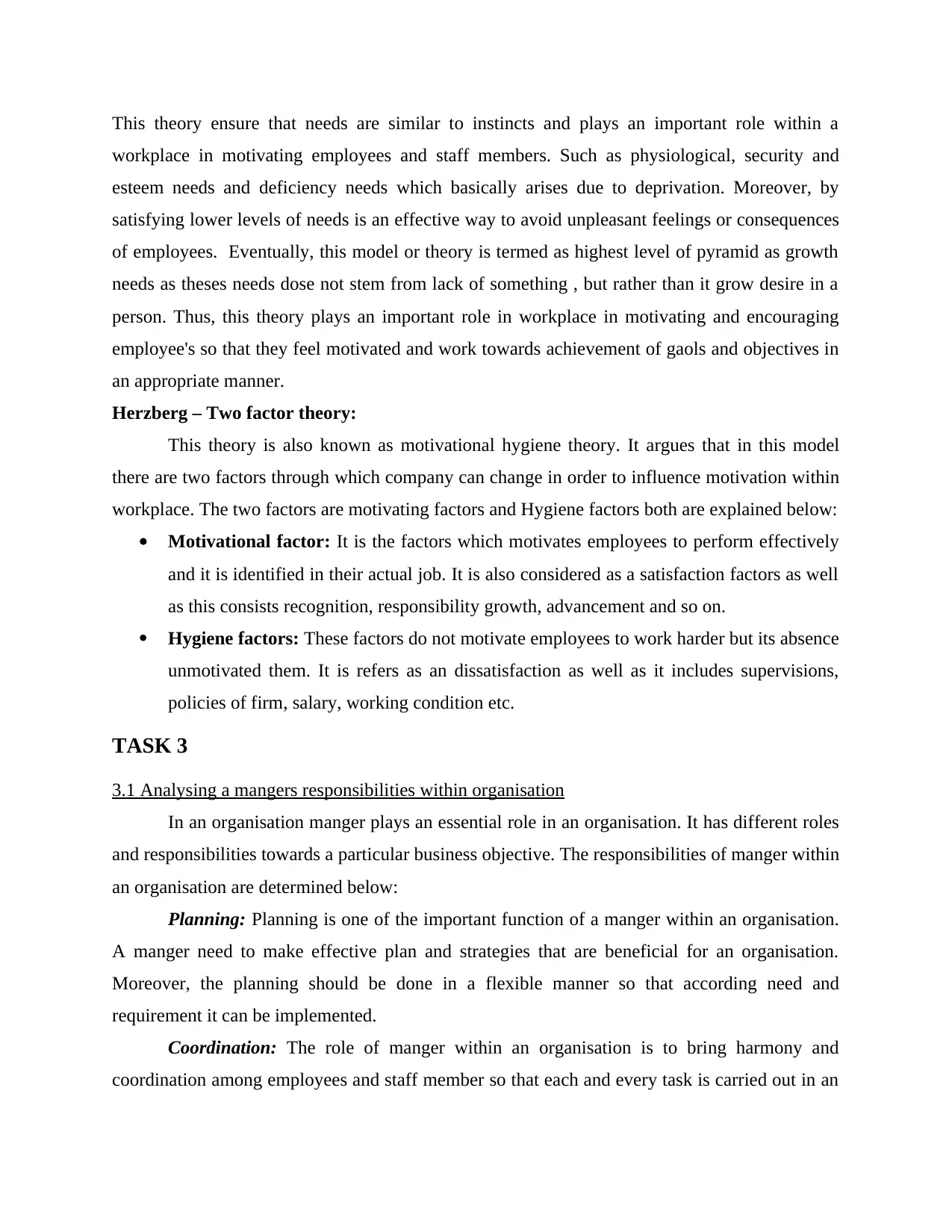
This theory ensure that needs are similar to instincts and plays an important role within a
workplace in motivating employees and staff members. Such as physiological, security and
esteem needs and deficiency needs which basically arises due to deprivation. Moreover, by
satisfying lower levels of needs is an effective way to avoid unpleasant feelings or consequences
of employees. Eventually, this model or theory is termed as highest level of pyramid as growth
needs as theses needs dose not stem from lack of something , but rather than it grow desire in a
person. Thus, this theory plays an important role in workplace in motivating and encouraging
employee's so that they feel motivated and work towards achievement of gaols and objectives in
an appropriate manner.
Herzberg – Two factor theory:
This theory is also known as motivational hygiene theory. It argues that in this model
there are two factors through which company can change in order to influence motivation within
workplace. The two factors are motivating factors and Hygiene factors both are explained below:
Motivational factor: It is the factors which motivates employees to perform effectively
and it is identified in their actual job. It is also considered as a satisfaction factors as well
as this consists recognition, responsibility growth, advancement and so on.
Hygiene factors: These factors do not motivate employees to work harder but its absence
unmotivated them. It is refers as an dissatisfaction as well as it includes supervisions,
policies of firm, salary, working condition etc.
TASK 3
3.1 Analysing a mangers responsibilities within organisation
In an organisation manger plays an essential role in an organisation. It has different roles
and responsibilities towards a particular business objective. The responsibilities of manger within
an organisation are determined below:
Planning: Planning is one of the important function of a manger within an organisation.
A manger need to make effective plan and strategies that are beneficial for an organisation.
Moreover, the planning should be done in a flexible manner so that according need and
requirement it can be implemented.
Coordination: The role of manger within an organisation is to bring harmony and
coordination among employees and staff member so that each and every task is carried out in an
workplace in motivating employees and staff members. Such as physiological, security and
esteem needs and deficiency needs which basically arises due to deprivation. Moreover, by
satisfying lower levels of needs is an effective way to avoid unpleasant feelings or consequences
of employees. Eventually, this model or theory is termed as highest level of pyramid as growth
needs as theses needs dose not stem from lack of something , but rather than it grow desire in a
person. Thus, this theory plays an important role in workplace in motivating and encouraging
employee's so that they feel motivated and work towards achievement of gaols and objectives in
an appropriate manner.
Herzberg – Two factor theory:
This theory is also known as motivational hygiene theory. It argues that in this model
there are two factors through which company can change in order to influence motivation within
workplace. The two factors are motivating factors and Hygiene factors both are explained below:
Motivational factor: It is the factors which motivates employees to perform effectively
and it is identified in their actual job. It is also considered as a satisfaction factors as well
as this consists recognition, responsibility growth, advancement and so on.
Hygiene factors: These factors do not motivate employees to work harder but its absence
unmotivated them. It is refers as an dissatisfaction as well as it includes supervisions,
policies of firm, salary, working condition etc.
TASK 3
3.1 Analysing a mangers responsibilities within organisation
In an organisation manger plays an essential role in an organisation. It has different roles
and responsibilities towards a particular business objective. The responsibilities of manger within
an organisation are determined below:
Planning: Planning is one of the important function of a manger within an organisation.
A manger need to make effective plan and strategies that are beneficial for an organisation.
Moreover, the planning should be done in a flexible manner so that according need and
requirement it can be implemented.
Coordination: The role of manger within an organisation is to bring harmony and
coordination among employees and staff member so that each and every task is carried out in an
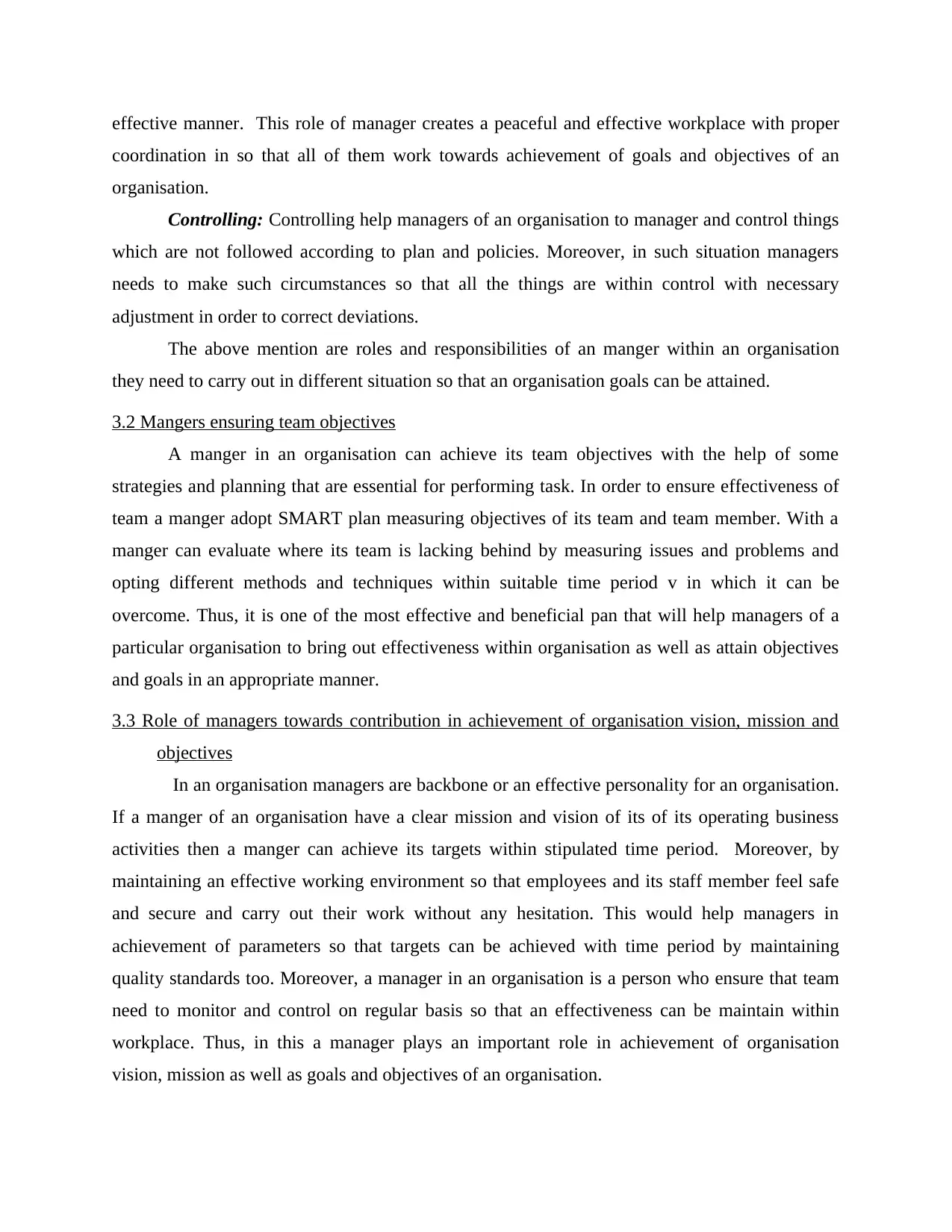
effective manner. This role of manager creates a peaceful and effective workplace with proper
coordination in so that all of them work towards achievement of goals and objectives of an
organisation.
Controlling: Controlling help managers of an organisation to manager and control things
which are not followed according to plan and policies. Moreover, in such situation managers
needs to make such circumstances so that all the things are within control with necessary
adjustment in order to correct deviations.
The above mention are roles and responsibilities of an manger within an organisation
they need to carry out in different situation so that an organisation goals can be attained.
3.2 Mangers ensuring team objectives
A manger in an organisation can achieve its team objectives with the help of some
strategies and planning that are essential for performing task. In order to ensure effectiveness of
team a manger adopt SMART plan measuring objectives of its team and team member. With a
manger can evaluate where its team is lacking behind by measuring issues and problems and
opting different methods and techniques within suitable time period v in which it can be
overcome. Thus, it is one of the most effective and beneficial pan that will help managers of a
particular organisation to bring out effectiveness within organisation as well as attain objectives
and goals in an appropriate manner.
3.3 Role of managers towards contribution in achievement of organisation vision, mission and
objectives
In an organisation managers are backbone or an effective personality for an organisation.
If a manger of an organisation have a clear mission and vision of its of its operating business
activities then a manger can achieve its targets within stipulated time period. Moreover, by
maintaining an effective working environment so that employees and its staff member feel safe
and secure and carry out their work without any hesitation. This would help managers in
achievement of parameters so that targets can be achieved with time period by maintaining
quality standards too. Moreover, a manager in an organisation is a person who ensure that team
need to monitor and control on regular basis so that an effectiveness can be maintain within
workplace. Thus, in this a manager plays an important role in achievement of organisation
vision, mission as well as goals and objectives of an organisation.
coordination in so that all of them work towards achievement of goals and objectives of an
organisation.
Controlling: Controlling help managers of an organisation to manager and control things
which are not followed according to plan and policies. Moreover, in such situation managers
needs to make such circumstances so that all the things are within control with necessary
adjustment in order to correct deviations.
The above mention are roles and responsibilities of an manger within an organisation
they need to carry out in different situation so that an organisation goals can be attained.
3.2 Mangers ensuring team objectives
A manger in an organisation can achieve its team objectives with the help of some
strategies and planning that are essential for performing task. In order to ensure effectiveness of
team a manger adopt SMART plan measuring objectives of its team and team member. With a
manger can evaluate where its team is lacking behind by measuring issues and problems and
opting different methods and techniques within suitable time period v in which it can be
overcome. Thus, it is one of the most effective and beneficial pan that will help managers of a
particular organisation to bring out effectiveness within organisation as well as attain objectives
and goals in an appropriate manner.
3.3 Role of managers towards contribution in achievement of organisation vision, mission and
objectives
In an organisation managers are backbone or an effective personality for an organisation.
If a manger of an organisation have a clear mission and vision of its of its operating business
activities then a manger can achieve its targets within stipulated time period. Moreover, by
maintaining an effective working environment so that employees and its staff member feel safe
and secure and carry out their work without any hesitation. This would help managers in
achievement of parameters so that targets can be achieved with time period by maintaining
quality standards too. Moreover, a manager in an organisation is a person who ensure that team
need to monitor and control on regular basis so that an effectiveness can be maintain within
workplace. Thus, in this a manager plays an important role in achievement of organisation
vision, mission as well as goals and objectives of an organisation.
⊘ This is a preview!⊘
Do you want full access?
Subscribe today to unlock all pages.

Trusted by 1+ million students worldwide
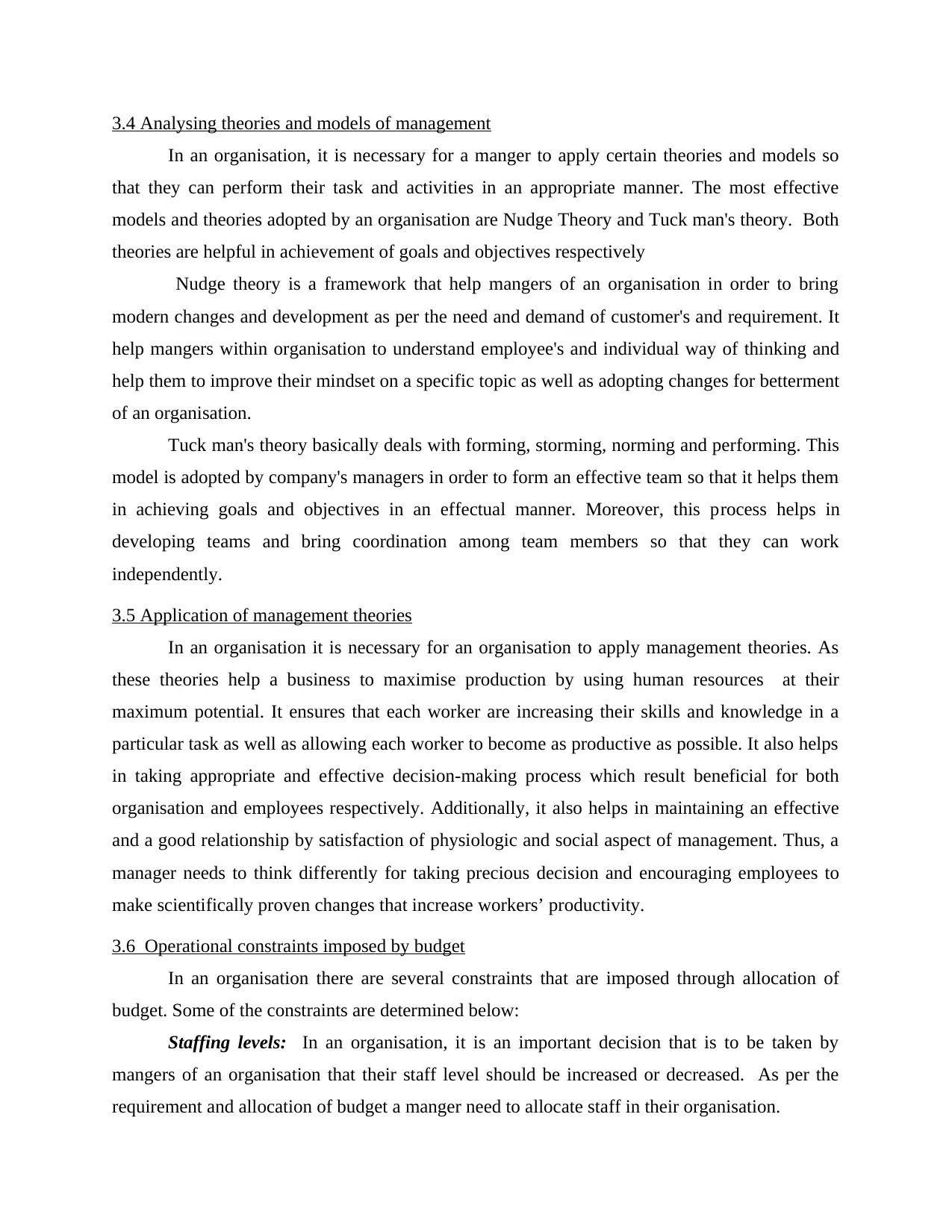
3.4 Analysing theories and models of management
In an organisation, it is necessary for a manger to apply certain theories and models so
that they can perform their task and activities in an appropriate manner. The most effective
models and theories adopted by an organisation are Nudge Theory and Tuck man's theory. Both
theories are helpful in achievement of goals and objectives respectively
Nudge theory is a framework that help mangers of an organisation in order to bring
modern changes and development as per the need and demand of customer's and requirement. It
help mangers within organisation to understand employee's and individual way of thinking and
help them to improve their mindset on a specific topic as well as adopting changes for betterment
of an organisation.
Tuck man's theory basically deals with forming, storming, norming and performing. This
model is adopted by company's managers in order to form an effective team so that it helps them
in achieving goals and objectives in an effectual manner. Moreover, this process helps in
developing teams and bring coordination among team members so that they can work
independently.
3.5 Application of management theories
In an organisation it is necessary for an organisation to apply management theories. As
these theories help a business to maximise production by using human resources at their
maximum potential. It ensures that each worker are increasing their skills and knowledge in a
particular task as well as allowing each worker to become as productive as possible. It also helps
in taking appropriate and effective decision-making process which result beneficial for both
organisation and employees respectively. Additionally, it also helps in maintaining an effective
and a good relationship by satisfaction of physiologic and social aspect of management. Thus, a
manager needs to think differently for taking precious decision and encouraging employees to
make scientifically proven changes that increase workers’ productivity.
3.6 Operational constraints imposed by budget
In an organisation there are several constraints that are imposed through allocation of
budget. Some of the constraints are determined below:
Staffing levels: In an organisation, it is an important decision that is to be taken by
mangers of an organisation that their staff level should be increased or decreased. As per the
requirement and allocation of budget a manger need to allocate staff in their organisation.
In an organisation, it is necessary for a manger to apply certain theories and models so
that they can perform their task and activities in an appropriate manner. The most effective
models and theories adopted by an organisation are Nudge Theory and Tuck man's theory. Both
theories are helpful in achievement of goals and objectives respectively
Nudge theory is a framework that help mangers of an organisation in order to bring
modern changes and development as per the need and demand of customer's and requirement. It
help mangers within organisation to understand employee's and individual way of thinking and
help them to improve their mindset on a specific topic as well as adopting changes for betterment
of an organisation.
Tuck man's theory basically deals with forming, storming, norming and performing. This
model is adopted by company's managers in order to form an effective team so that it helps them
in achieving goals and objectives in an effectual manner. Moreover, this process helps in
developing teams and bring coordination among team members so that they can work
independently.
3.5 Application of management theories
In an organisation it is necessary for an organisation to apply management theories. As
these theories help a business to maximise production by using human resources at their
maximum potential. It ensures that each worker are increasing their skills and knowledge in a
particular task as well as allowing each worker to become as productive as possible. It also helps
in taking appropriate and effective decision-making process which result beneficial for both
organisation and employees respectively. Additionally, it also helps in maintaining an effective
and a good relationship by satisfaction of physiologic and social aspect of management. Thus, a
manager needs to think differently for taking precious decision and encouraging employees to
make scientifically proven changes that increase workers’ productivity.
3.6 Operational constraints imposed by budget
In an organisation there are several constraints that are imposed through allocation of
budget. Some of the constraints are determined below:
Staffing levels: In an organisation, it is an important decision that is to be taken by
mangers of an organisation that their staff level should be increased or decreased. As per the
requirement and allocation of budget a manger need to allocate staff in their organisation.
Paraphrase This Document
Need a fresh take? Get an instant paraphrase of this document with our AI Paraphraser
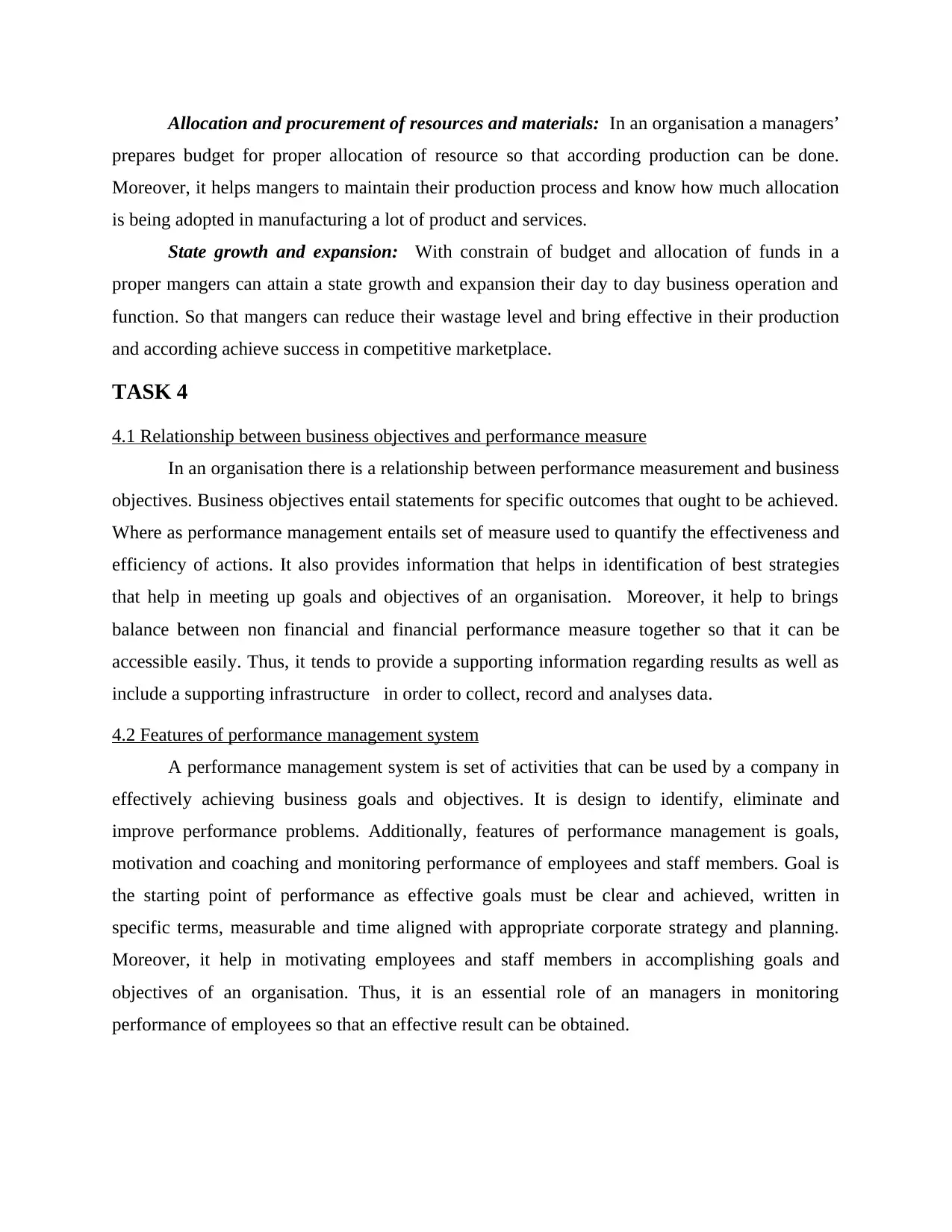
Allocation and procurement of resources and materials: In an organisation a managers’
prepares budget for proper allocation of resource so that according production can be done.
Moreover, it helps mangers to maintain their production process and know how much allocation
is being adopted in manufacturing a lot of product and services.
State growth and expansion: With constrain of budget and allocation of funds in a
proper mangers can attain a state growth and expansion their day to day business operation and
function. So that mangers can reduce their wastage level and bring effective in their production
and according achieve success in competitive marketplace.
TASK 4
4.1 Relationship between business objectives and performance measure
In an organisation there is a relationship between performance measurement and business
objectives. Business objectives entail statements for specific outcomes that ought to be achieved.
Where as performance management entails set of measure used to quantify the effectiveness and
efficiency of actions. It also provides information that helps in identification of best strategies
that help in meeting up goals and objectives of an organisation. Moreover, it help to brings
balance between non financial and financial performance measure together so that it can be
accessible easily. Thus, it tends to provide a supporting information regarding results as well as
include a supporting infrastructure in order to collect, record and analyses data.
4.2 Features of performance management system
A performance management system is set of activities that can be used by a company in
effectively achieving business goals and objectives. It is design to identify, eliminate and
improve performance problems. Additionally, features of performance management is goals,
motivation and coaching and monitoring performance of employees and staff members. Goal is
the starting point of performance as effective goals must be clear and achieved, written in
specific terms, measurable and time aligned with appropriate corporate strategy and planning.
Moreover, it help in motivating employees and staff members in accomplishing goals and
objectives of an organisation. Thus, it is an essential role of an managers in monitoring
performance of employees so that an effective result can be obtained.
prepares budget for proper allocation of resource so that according production can be done.
Moreover, it helps mangers to maintain their production process and know how much allocation
is being adopted in manufacturing a lot of product and services.
State growth and expansion: With constrain of budget and allocation of funds in a
proper mangers can attain a state growth and expansion their day to day business operation and
function. So that mangers can reduce their wastage level and bring effective in their production
and according achieve success in competitive marketplace.
TASK 4
4.1 Relationship between business objectives and performance measure
In an organisation there is a relationship between performance measurement and business
objectives. Business objectives entail statements for specific outcomes that ought to be achieved.
Where as performance management entails set of measure used to quantify the effectiveness and
efficiency of actions. It also provides information that helps in identification of best strategies
that help in meeting up goals and objectives of an organisation. Moreover, it help to brings
balance between non financial and financial performance measure together so that it can be
accessible easily. Thus, it tends to provide a supporting information regarding results as well as
include a supporting infrastructure in order to collect, record and analyses data.
4.2 Features of performance management system
A performance management system is set of activities that can be used by a company in
effectively achieving business goals and objectives. It is design to identify, eliminate and
improve performance problems. Additionally, features of performance management is goals,
motivation and coaching and monitoring performance of employees and staff members. Goal is
the starting point of performance as effective goals must be clear and achieved, written in
specific terms, measurable and time aligned with appropriate corporate strategy and planning.
Moreover, it help in motivating employees and staff members in accomplishing goals and
objectives of an organisation. Thus, it is an essential role of an managers in monitoring
performance of employees so that an effective result can be obtained.
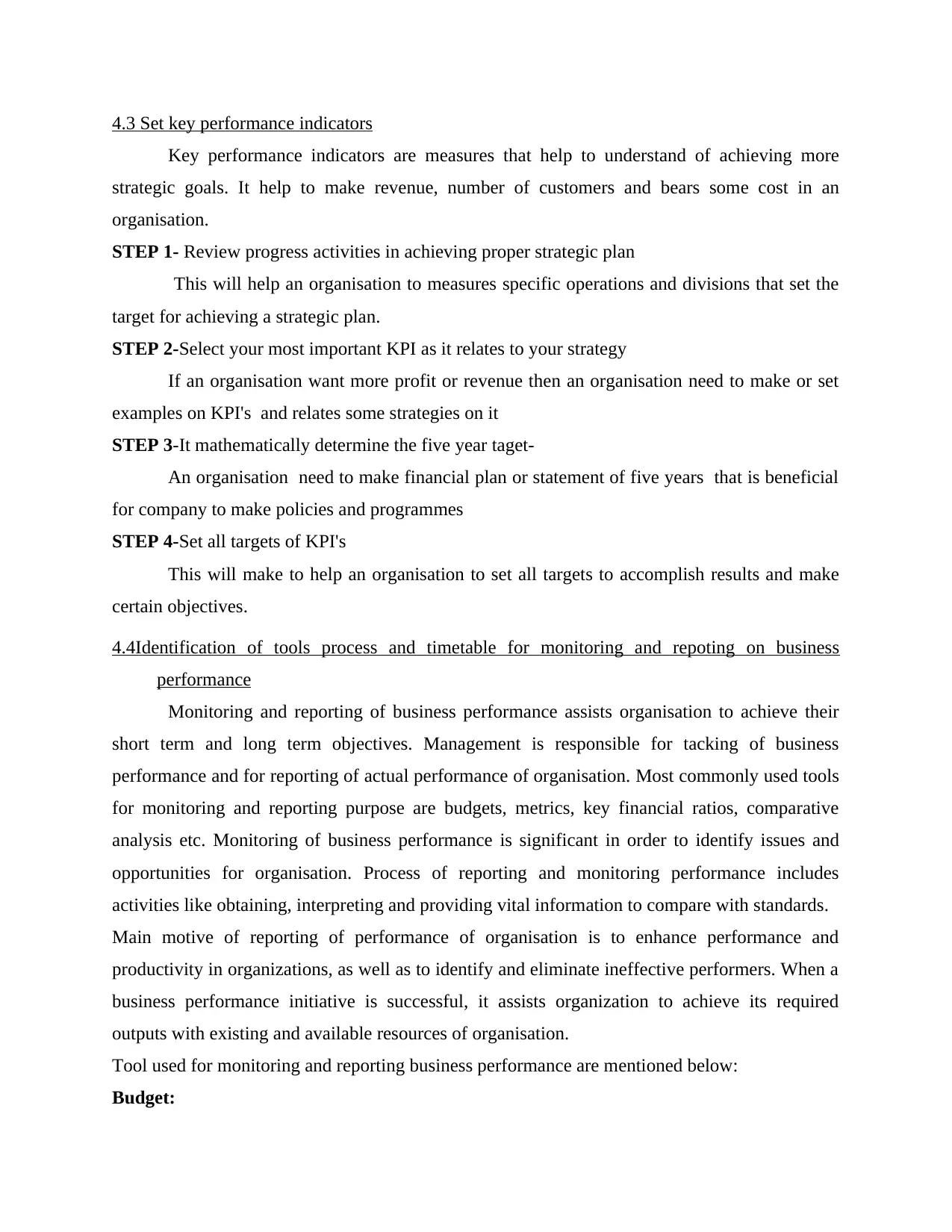
4.3 Set key performance indicators
Key performance indicators are measures that help to understand of achieving more
strategic goals. It help to make revenue, number of customers and bears some cost in an
organisation.
STEP 1- Review progress activities in achieving proper strategic plan
This will help an organisation to measures specific operations and divisions that set the
target for achieving a strategic plan.
STEP 2-Select your most important KPI as it relates to your strategy
If an organisation want more profit or revenue then an organisation need to make or set
examples on KPI's and relates some strategies on it
STEP 3-It mathematically determine the five year taget-
An organisation need to make financial plan or statement of five years that is beneficial
for company to make policies and programmes
STEP 4-Set all targets of KPI's
This will make to help an organisation to set all targets to accomplish results and make
certain objectives.
4.4Identification of tools process and timetable for monitoring and repoting on business
performance
Monitoring and reporting of business performance assists organisation to achieve their
short term and long term objectives. Management is responsible for tacking of business
performance and for reporting of actual performance of organisation. Most commonly used tools
for monitoring and reporting purpose are budgets, metrics, key financial ratios, comparative
analysis etc. Monitoring of business performance is significant in order to identify issues and
opportunities for organisation. Process of reporting and monitoring performance includes
activities like obtaining, interpreting and providing vital information to compare with standards.
Main motive of reporting of performance of organisation is to enhance performance and
productivity in organizations, as well as to identify and eliminate ineffective performers. When a
business performance initiative is successful, it assists organization to achieve its required
outputs with existing and available resources of organisation.
Tool used for monitoring and reporting business performance are mentioned below:
Budget:
Key performance indicators are measures that help to understand of achieving more
strategic goals. It help to make revenue, number of customers and bears some cost in an
organisation.
STEP 1- Review progress activities in achieving proper strategic plan
This will help an organisation to measures specific operations and divisions that set the
target for achieving a strategic plan.
STEP 2-Select your most important KPI as it relates to your strategy
If an organisation want more profit or revenue then an organisation need to make or set
examples on KPI's and relates some strategies on it
STEP 3-It mathematically determine the five year taget-
An organisation need to make financial plan or statement of five years that is beneficial
for company to make policies and programmes
STEP 4-Set all targets of KPI's
This will make to help an organisation to set all targets to accomplish results and make
certain objectives.
4.4Identification of tools process and timetable for monitoring and repoting on business
performance
Monitoring and reporting of business performance assists organisation to achieve their
short term and long term objectives. Management is responsible for tacking of business
performance and for reporting of actual performance of organisation. Most commonly used tools
for monitoring and reporting purpose are budgets, metrics, key financial ratios, comparative
analysis etc. Monitoring of business performance is significant in order to identify issues and
opportunities for organisation. Process of reporting and monitoring performance includes
activities like obtaining, interpreting and providing vital information to compare with standards.
Main motive of reporting of performance of organisation is to enhance performance and
productivity in organizations, as well as to identify and eliminate ineffective performers. When a
business performance initiative is successful, it assists organization to achieve its required
outputs with existing and available resources of organisation.
Tool used for monitoring and reporting business performance are mentioned below:
Budget:
⊘ This is a preview!⊘
Do you want full access?
Subscribe today to unlock all pages.

Trusted by 1+ million students worldwide
1 out of 15
Related Documents
Your All-in-One AI-Powered Toolkit for Academic Success.
+13062052269
info@desklib.com
Available 24*7 on WhatsApp / Email
![[object Object]](/_next/static/media/star-bottom.7253800d.svg)
Unlock your academic potential
Copyright © 2020–2025 A2Z Services. All Rights Reserved. Developed and managed by ZUCOL.





